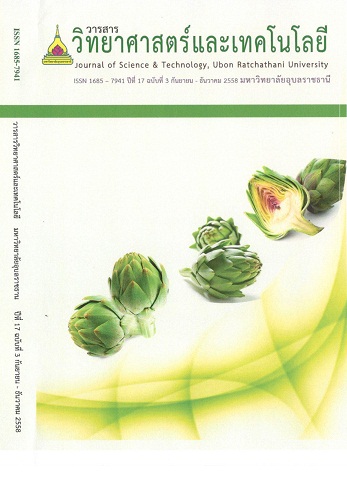Production of Coconut Milk Mixed Whipped Cream for Food Services and Catering
Main Article Content
บทคัดย่อ
Coconut oil is mainly composed of medium-sized saturated fatty acid which does not make free radical and trans fat that are harmful to health. The objective of this research was to study the production of coconut milk mixed whipped cream to enhance the utilization of coconut milk as an alternative for application in fusion food, a combination of national foods. The cream was prepared by the mixture of non-dairy whipped cream and coconut milk at ratios of 1:0, 1:1, 1:1.25, 1:1.50, and 1:1.75, and boiled for 15 seconds. The mixtures were stirred with a hand-mixer for five minutes prior to evaluations of the foam capacities and foam stabilities. It was found that increased coconut milk in the ratios decreased the foam capacities and foam stabilities significantly (p<0.05). Various amounts of three kinds of hydrocolloids (carboxyl methylcellulose, carrageenan, and hydroxyl methylcellulose) were added to the mixtures of the creams prepared from non-dairy whipped cream and coconut milk at a ratio of 1:1.50 to improve the quality of the foam. The results showed that the use of 0.2% of hydroxyl methylcellulose significantly improved the quality of the creams. Foam capacities and foam stabilities of the creams were not significantly different from the non-dairy whipped cream. The shelf-life periods of the coconut milk mixed whipped creams were studied by storage at 4oC and the qualities of the foams were evaluated and microbiological tests were completed every two days. It was found that the creams were satisfactory for more than 14 days. Also, the coconut milk mixed whipped creams were given to restaurant owners, chefs, and food professionals in 20 places to assess their satisfaction with their use. The results showed a significant acceptance (p≤.05) by these persons.
น้ำมันมะพร้าวประกอบด้วยกรดไขมันอิ่มตัวขนาดปานกลาง ซึ่งไม่ทำปฏิกิริยากับอนุมูลอิสระ และไม่ทำให้เกิดไขมันทรานส์ที่เป็นอันตรายต่อสุขภาพ เพื่อเป็นการส่งเสริมการใช้ประโยชน์ของกะทิ รวมทั้งเพื่อประยุกต์การใช้กะทิในอาหารรูปแบบที่มีการผสมผสานระหว่างวัฒนธรรม 2 แบบ (fusion food) ผู้วิจัยจึงสนใจในการนำกะทิมาพัฒนาให้เป็นผลิตภัณฑ์ใหม่ เพื่อส่งเสริมความเป็นสากลของกะทิไทย โดยการทดลอง พัฒนาผลิตภัณฑ์ วิปปิ้งครีมผสมกะทิ ในอัตราส่วนของวิปปิ้งครีม (Non-dairy) และกะทิเท่ากับ 1:1, 1;1.25, 1;1.50 และ 1:1.75 นำส่วนผสมไปต้มจนเดือด เป็นเวลา 15 นาที แล้วนำส่วนผสมมาตีด้วยเครื่องตีไขแบบมือ เป็นเวลา 5 นาที วิเคราะห์ความสามารถการขึ้นฟูของโฟม (foam capacity) และความคงตัวของโฟม (foam stability) พบว่า ความสามารถการขึ้นฟูและความคงตัวของโฟมมีแนวโน้มลดลง เมื่ออัตรา p≤0.5 จากนั้น นำวิปปิ้งครีมผสมกะทิในอัตราส่วน 1:1.50 มาพัฒนาคุณภาพ โดยเติมสารไฮโดรคอลลอยด์ 3 ชนิด ได้แก่ คาร์บอกซิลเมทิลเซลลูโลส คาราจีแนน และไฮดรอกซี โพรพิลเมทิลเซลลูโลส เพื่อปรับปรุงคุณภาพของโฟม ผลการทดลองพบว่า การใช้ไฮดรอกซีโพรพิลเมทิลเซลลูโลส ในปริมาณ 0.2 เปอร์เซ็นต์ ทำให้ความสามารถในการขึ้นฟูไม่แตกต่างจากวิปปื้งครีมที่ไม่เติมกะทิ จากนั้นนำวิปปิ้งครีมผสมกะทิ ที่ได้รับการปรับปรุงแล้ว มาศึกษาอายุการเก็บรักษา โดยเก็บรักษาที่ อุณหภูมิ 4 องศาเซลเซียส นำวิปปิ้งครีมผสมกะทิ มาวัดคุณภาพของโฟม และวิเคราะห์คุณภาพด้านจุลินทรีย์ ผลการทดลองพบว่า วิปปิ้งครีมผสมกะทิ สามารถเก็บได้อย่างน้อย 14 วัน หลังจากนั้นนำวิปปิ้งครีมผสมกะทิ ไปทดสอบกับผู้ประกอบอาหาร เชฟ และผู้เชี่ยวชาญด้านอาหารจำนวน 20 แห่ง พบว่า ผู้ทดสอบในธุรกิจการจัดและบริการอาหารยอมรับวิปปิ้งครีมผสมกะทิ อย่างมีระดับนัยสำคัญทางสถิติ (p0.5)
Article Details
บทความที่ได้รับการตีพิมพ์เป็นลิขสิทธิ์ของ วารสารวิทยาศาสตร์และเทคโนโลยี มหาวิทยาลัยอุบลราชธานี
ข้อความที่ปรากฏในบทความแต่ละเรื่องในวารสารวิชาการเล่มนี้เป็นความคิดเห็นส่วนตัวของผู้เขียนแต่ละท่านไม่เกี่ยวข้องกับมหาวิทยาลัยอุบลราชธานี และคณาจารย์ท่านอื่นๆในมหาวิทยาลัยฯ แต่อย่างใด ความรับผิดชอบองค์ประกอบทั้งหมดของบทความแต่ละเรื่องเป็นของผู้เขียนแต่ละท่าน หากมีความผิดพลาดใดๆ ผู้เขียนแต่ละท่านจะรับผิดชอบบทความของตนเองแต่ผู้เดียว


